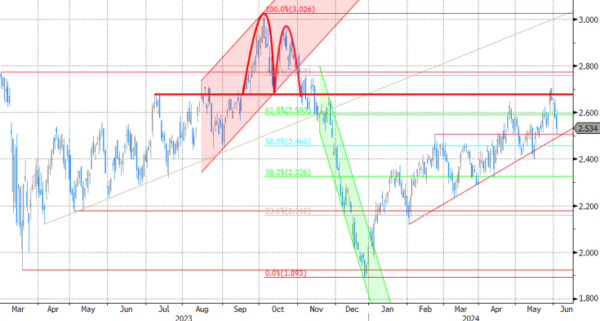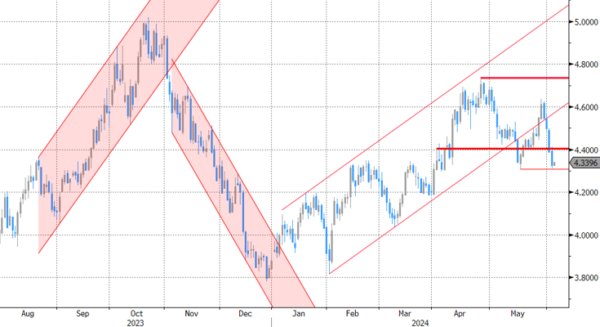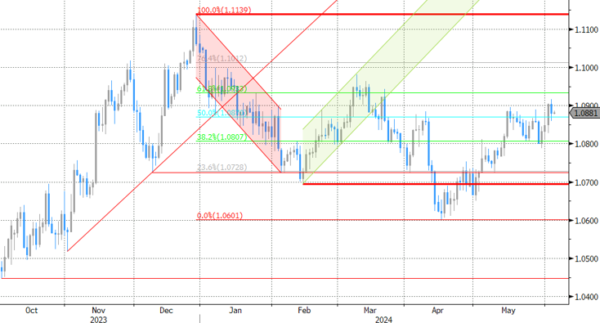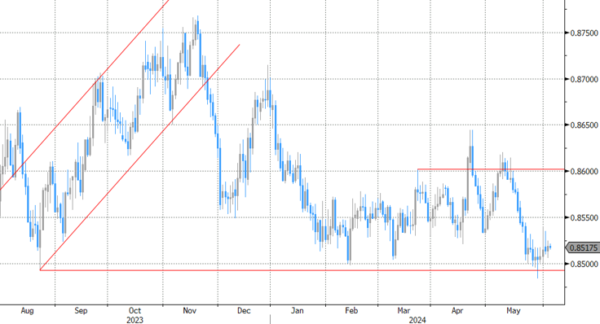Markets
The three-day Treasury rally morphed into a four-day advance yesterday. The common theme is some worry on (US) growth momentum. It all started last Thursday with downward revisions to Q1 GDP data (especially consumption). Slightly disappointing spending data on Friday, a steeper drop in new orders in the manufacturing sector on Monday and a sharp reduction in the amount of outstanding US vacancies (JOLTS report; lowest tally since February 2021) yesterday all provided core bond momentum. Oil prices trade $7/b lower (Brent) over the same time period adding a virtuous element to the bond rally. US yields lost another 3.8 bps (2-yr) to 6.8 bps (7-yr) yesterday with the US 10-yr yield testing the mid-May range bottom at 4.31%. The past sessions’ move is mainly triggered by a drop in real rates. US Treasuries outperformed German Bunds with German yields closing 3.5 bps to 4.6 bps lower on the day. Technical resistance (EUR/USD 1.09-area) and the approaching ECB-meeting prevented a more EUR/USD gains with the pair finishing at 1.0879. Risk sentiment on stock markets soured in Europe (-1%), but Wall Street eventually managed to turn a negative start into a slightly positive finish.
Today’s US eco calendar contains ADP employment change and services ISM. Consensus expects another solid job growth figure (+175k) while the services ISM is forecast to undo last month’s slip below the 50 boom/bust mark which was only the second since the early stages of the Covid-outbreak. From a short-term point of view, we believe that any form of disappointment in the data could still extend the Treasury rally with the 4.31%-mark in the US 10-yr yield at risk of giving away. Next levels to watch are 4.25% (50% retracement on this year’s upmove) and 4.19% (early April low). We expect EUR/USD to hold below 1.09 given the risk of euro weakness in the wake of the flagged ECB rate cut which will automatically trigger anticipation on more to come and more than at is currently discounted.
News & Views
A survey of the UK Think Thank ‘Official Monetary and Financial Institutions Forum’ (OMFIF) sees a potential change in the allocation strategy of global reserve managers. OMFIF surveyed 73 central banks with $5.4tn of international reserves under management. In the wake of the 2008 financial crisis, diversification was a key consideration. In the period of the pandemic and the war in Ukraine, assessment managers turned to safe have currencies and assets. According to OMFIF ,this year the percentage of reserve managers that expects to go risk-on in their portfolios has doubled to 29% from 14% in 2023. On currencies, cyclical factors are driving reserve managers towards the dollar. Over the next 12-24 months, a net 18% of respondents expect to increase their allocation to the dollar primarily due to the positive outlook for the US economy and higher interest rates. The euro is next highest at net 7%, suggesting that reserve managers will double down on traditional reserve currencies Appetite for the renminbi has soured. Even after a rise of the share of gold from 9% to 11% last year, 15% of the respondents indicate to raise the proportion of gold in a 1-2y horizon.
The Australian economy grew a modest 0.1% Q/Q in the first quarter of the year. Activity in this respect was 1.1% higher compared to the same period in 2023. The Australian Bureau of Statistics said that “GDP growth was weak in March, with the economy experiencing its lowest through the year growth since December 2020. GDP per capita fell for the fifth consecutive quarter, falling 0.4% in March and 1.3% through the year”. Household spending rose 0.4% Q/Q, but this was mostly on essentials like electricity, health, rent and food. Capital investment decreased 0.9%. Net exports subtracted 0.9 ppts from growth. Inventories via higher imports add 0.7 ppts. Despite modest spending growth, the household savings ratio declined to 0.9% as income received grew at the lowest rate since December 2021. Still, with inflation showing sticky (3.6% Y/Y CPI in April), there is little room for the RBA to embark for an easing cycle anytime soon. AUD/USD trades little changed near 0.665.
Graphs
GE 10y yield
ECB President Lagarde clearly hinted at a June rate cut which has broad backing. A more bumpy inflation path in H2 2024, the EMU economy gradually regaining traction and the Fed’s higher for longer US strategy make follow-up moves difficult. Markets are coming to terms with that. The German 10y yield set a new YtD top at 2.7%.
US 10y yield
The Fed in May acknowledged the lack of progress towards the 2% inflation objective, but Fed Chair Powell indicated that further tightening was unlikely. However, the FOMC Minutes still showed internal debate on whether policy is restrictive enough. Sticky inflation suggests any rate cut will be a tough balancing act while several policy makers hint at a higher neutral rate. The US 10-y yield is stuck in the 4.3/4.7% trading range.
EUR/USD
Economic divergence, a likely desynchronized rate cut cycle with the ECB exceptionally taking the lead and higher than expected US CPI data pushed EUR/USD to the 1.06 area. From there, better EMU data gave the euro some breathing space. The dollar lost further momentum on softer than expected early May US data. Some further consolidation in the 1.06/1.09 area might be on the cards short-term.
Debate at the Bank of England is focused at the timing of rate cuts. Slower than expected April disinflation and a surprise general election on July 4 suggest that a June cut in line with the ECB looks improbable. Sterling gained momentum with money markets now discounting a Fed-like scenario. EUR/GBP tested the 2023 & 2024 lows near 0.85. We expect this important support level to hold.








![Week ahead – ECB set to cut, BoC might pause as Trump U-turns on tariffs [Video]](https://www.actionforex.com/wp-content/uploads/2018/04/f-ecb29-218x150.jpg)









